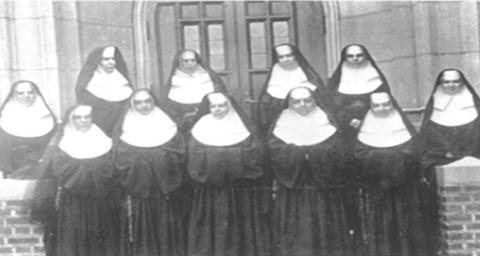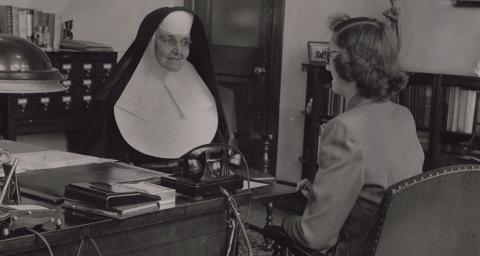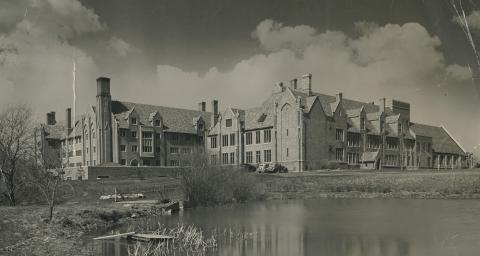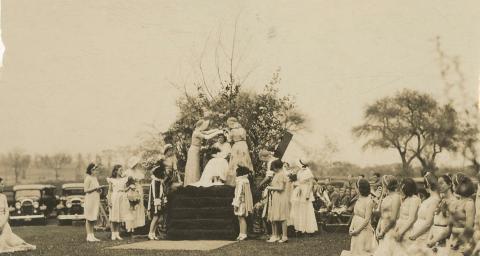History of Mercyhurst University
The story of Mercyhurst begins across the Atlantic Ocean in the city of Dublin. There, on historic Baggot Street, Catherine Elizabeth McAuley founded a new religious congregation—the Sisters of Mercy—in 1831. The Sisters of Mercy pledged to uphold not only the traditional vows of poverty, chastity, and obedience but a fourth vow as well—the vow of service. They made it their mission to improve the lives of those suffering from poverty or illness and to elevate underserved communities through education. This mission drove their ministry, propelling the spread of the order first across Ireland and England and then, in 1843, to the United States. Seven Sisters of Mercy made the transatlantic voyage, settling in the city of Pittsburgh to establish a convent there. From Pittsburgh, a group of Sisters traveled northeast to Titusville, setting up several schools in the region over the years that followed.

Following the success of their educational ministry in these years, the Sisters of Mercy set their sights further north. Just as founder Catherine McAuley had sought to uplift women through the Mercy ministry, the Sisters of Mercy in Erie believed passionately in the need to empower the women of this region through education. They recognized that women in Erie and beyond lacked opportunities for higher education. To remedy this, the Sisters of Mercy in the Diocese of Erie founded Mercyhurst College on a hill overlooking Lake Erie. The all-female college, they were certain, would provide a top-notch education in a range of disciplines, preparing its students for success as homemakers, new Sisters of Mercy, and, increasingly, as career women.
Leading the effort was Mother M. Borgia Egan, whose determination and supervision made the venture a success. Born Catherine Egan in DuBois into an Irish Catholic family, she became a postulant to the Sisters of Mercy at age 14. Her service as principal of a Mercy school in DuBois exemplified her commitment to Mercy education and leadership ability. Some of her greatest strengths were her intelligence and decisiveness – once she had made a decision, she never wavered in seeing it through.

While it is unclear when or how Mother Borgia decided to pursue the creation of a college for women, the decision undoubtedly was shaped by broader social trends. At the time, Catholic youth increasingly sought opportunities to pursue higher education in a Catholic setting, but these opportunities were limited. On a practical level, the high enrollment at Catholic grade schools meant a higher demand for qualified schoolteachers with bachelor’s degrees. For the Sisters of Mercy, opening a college where Sisters could be educated would ensure their members would be well-prepared to serve the community through the ministries of medicine and education. With the support and advice of Bishop Gannon and Father Thomas Gasson, then-president of Boston College, Mother Borgia led the Sisters of Mercy through the process of immense change as they moved their headquarters from Titusville to Erie and began planning for the creation of a women’s college there.

Despite others’ doubts, Mother Borgia remained firm in the belief that the Sisters of Mercy would find and raise the funds for the project. She won the admiration and respect of many as she worked to make the dream of Mercyhurst College a reality, guiding the Sisters through challenges like the cost of the project and the final, frantic efforts to finish construction after a workers’ strike left the completion of work on Old Main and Egan Hall in the Sisters’ hands. With hard work and determination, under Mother Borgia’s leadership, the Sisters’ efforts paid off.
The laying of the cornerstone for the original college complex, envisioned as a classical Gothic structure, occurred on August 25, 1925, and drew a crowd of thousands of onlookers. A year later, Mercyhurst College opened its doors to its first group of students on September 20, 1926. At the time, twenty-three young women comprised its student body, while its faculty consisted of seventeen Sisters of Mercy. In the years that followed, construction was completed on several signature features of the campus, including Christ the King Chapel, O’Neil Tower, and the Grotto. The Sisters of Mercy also maintained a Seminary for the education of teenage girls; the Seminary was housed on the Mercyhurst College campus until 1963 when it was moved to a new building and took on a new name – Mercyhurst Prep.

Mercyhurst College earned its charter from the state of Pennsylvania in 1928, and accreditation from Middle States followed three years later. It was the first institution in the Erie region to grant college-level education to young women. Despite the challenges of these early decades, including the Great Depression and World War II, this was a time of growth and joy for the institution. In 1929, students published the first edition of The Merciad; the student newspaper has remained active ever since. 1930 saw the creation of the first sports teams, and in 1934, the first wedding to be held in Christ the King Chapel took place. These formative years saw the establishment of crucial traditions, traditions like May Day festivities, formal dinners, and the Orphan’s Party that combined socialization and fun with educational and charitable experience.
As the college grew in enrollment, the sprawling campus saw the construction of new buildings to accommodate student life and academics. These buildings – like Weber and Preston Hall – have changed in function over the years but remain an integral part of the campus. In 1950, Mercyhurst gained another iconic symbol in the form of the magnificent wrought iron gates that mark the main entrance to campus. Academically, the college continued to establish a reputation for excellence. Throughout its history, Mercyhurst has taken considerable pride in developing signature programs that are unlike offerings anywhere else in the nation. During these years, one such program was the Cadet Teacher Program, which ran for nearly half a century and centered on equipping students with real-world teaching experience.
The 1960s were a period of transition across the nation, and Mercyhurst saw its fair share of change as well. As students underwent a shift in consciousness, they turned away from old traditions and sought new directions; for example, the iconic May Day festivities that had been a defining part of campus life for so many years were held for the last time in the late 1960s after students expressed a lack of interest in continuing an event that was both old-fashioned and costly.
But the biggest change in those years, and certainly one of the most significant shifts in Mercyhurst’s history, occurred at the close of the decade. In February 1969, recognizing the changes sweeping the nation’s social fabric, as well as academic demand and economic forces, Mercyhurst’s Board of Trustees voted to make Mercyhurst a coeducational institution. For the first time in its history, Mercyhurst welcomed male students alongside female students that fall. Sister Carolyn Hermann, then-president of Mercyhurst, oversaw the transition, which ushered in further expansion as facilities were repurposed and constructed anew to accommodate the male students. It was not long before Mercyhurst, long known as a women-only institution, reached equilibrium in its balance of male and female students.
A decade after becoming coeducational, Mercyhurst marked another milestone with the offering of its first graduate program in 1978. Since then, its graduate offerings have expanded to include thirteen master’s degrees and ten graduate certificates. The Laker football team debuted in 1981, winning its first game and from that day forward being a key element of campus life and school spirit. To keep up with student demand, Mercyhurst continued to expand its roster of athletic programs, attracting standout student-athletes in a range of sports. Continuing its tradition of developing signature programs, Mercyhurst debuted its Research Intelligence Analysis Program (RIAP) in 1992. It was the first four-year degree program in the nation designed to prepare students for a career in intelligence analysis.
In the twenty-first century, Mercyhurst has adapted to changing times – and continually sets itself ahead of the curve. With new traditions like the Mass of the Holy Spirit and Hurst Day to bring the community together and new offerings like the Cybersecurity program, Mercyhurst puts its motto of Carpe Diem into practice. In 2012, Mercyhurst gained university status, a major milestone. As Mercyhurst University approaches its centennial celebration, it can look back on its past with pride. From a women’s college that began with twenty-three students and 17-sister faculty, the university has grown to enroll approximately 3,000 undergraduate and graduate students in an impressive variety of disciplines – a far cry from its humble beginnings. But in all those years, despite all the changes and challenges they held, Mercyhurst has remained loyal to its roots in the Mercy tradition. Its success and growth are a testament to the longevity of the Sisters’ vision of a “college upon a hill,” a vision they worked diligently to make reality and one which has so drastically shaped the lives of all those who call Mercyhurst home.
The Mercyhurst University Archives proudly capture the illustrious, inspiring history of the institution and those connected to it. We at the Archives welcome you to explore Mercyhurst’s history in greater depth.